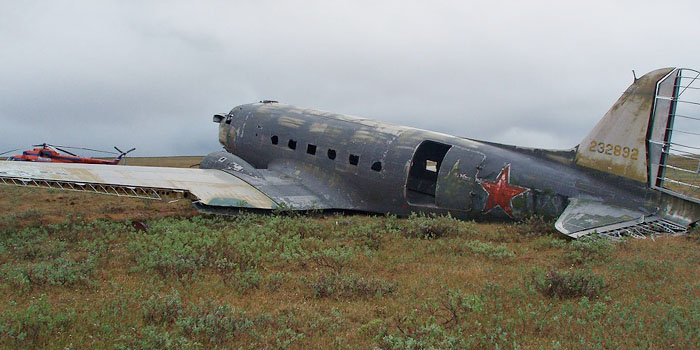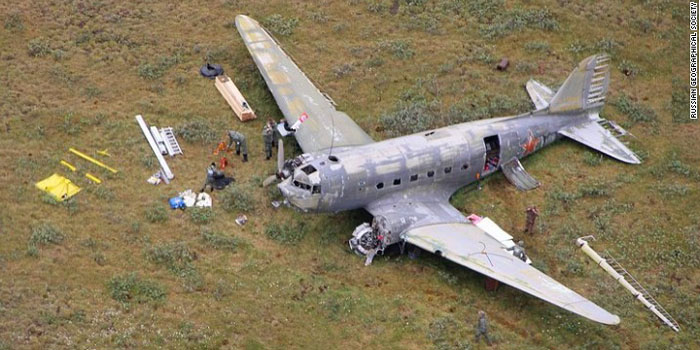Updated on September 29, 2023
The C-47 Skytrain was a military derivative of the civilian DC-3. While the
DC-3 prototype first flight was made from Clover Field (now Santa Monica) on
17th December 1935, the deliveries of C-47s to the U.S.Army Air Force started
in 1941; in the meanwhile, other military variants, closer to the civilian DC-3,
had been produced; one was the C-53 Skytrooper, specialized for troops transport
; it lacked the cargo door, hoist attachment and reinforced floor; so only 380
were built and the production was mainly focused on the C-47 that was more versatile.
The C-47 differed from the civilian DC-3 for many modifications:
- more powerful engines: two Pratt & Whitney R-1830-92 Twin Wasp, 14-cylinder
radial air-cooled engines, 1,200 horsepower each;
- the replacement of many components made in welded tubes (engine mounting
rings, parts of the landing gear) with forged or cast ones, quicker to build;
- the centre wing section was increased of 150 mm, and the length reduced
by 230 mm;
- the removal of airline seating in favor of utility seats along the walls;
- large cargo doors on the left-rear side, split into two halves that opened
rotating outside;
- four men crew and seats for 28 troops alongside into the fuselage;
- hoist attachment;
- strengthened rear fuselage and floor; the floor section close to the cargo
door was angulated to be parallel to the ground to make loading easier;
- shorter tail cone for glider-towing shackles;
- astrodome in the cabin roof.
10,629 DC-3, C-47 and reated variants were built in Long Beach, Santa Monica
ans Oklahoma City facilities.
The C-47 was supplied to many foreign users; it was nicknamed Dakota in British
and Commonwealth service. The R4D was the Navy version of the C-47.
The end of this page is to describe the versions that were supplied to the
Soviet Union with the Lend-Lease program; other versions aren't described here.
C-47
It was the initial version,
As visual characteristic, it had intakes for the supercharger of small
type, eventually with a long filter located over the cowling.
It had a combustion heater inside the fuselage that was connected to
a small exhaust atop the fuselage, close to the astrodome; it hadn't
some small pipes on the exhaust stacks that appeared only in later versions.
Codes started from 41-7722 C-47-DL and ended with 42-5704 C-47-DL (with
wide gaps; the numeration was common to all US types); 965 C-47 were
built in Long Beach plant (DL) in 1941-42. The first number represent
the year of commission; the delivery could have been made in the following
year.
On the tails, the first digit '4' was usually omitted, so the numbers
painted in yellow on the tail of this version can be from 17722 to 25704. |
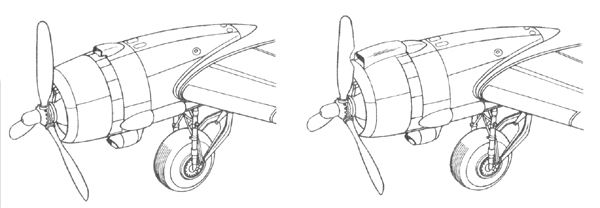 Adapted from
Aviakollectsia Adapted from
Aviakollectsia
|
C-47A
Differed from C-47 mainly for its electrical plant and for having a
fuselage heating system recovering heat from the exhaust pipes; smaller
pipes on the exhaust stacks, absent on C-47, were visible on C-47A.
On early production C-47A, the supercharger intakes were as those of
C-47, with or without the long filter atop the cowling; late production
C-47A had an internal filter, and the supercharger intakes were bulged
on their rear.
The serials started with 42-23300 and ended with 43-48262 (with wide
gaps; the numeration was common to all US types); 5254 were built in
Long Beach plant (DL) and in Oklahoma City plant (DK). The first number
represent the year of commission; the delivery could have been made
in the following year.
On the tails, the first digit '4' was usually omitted, so the numbers
painted in yellow on the tail of this version can be from 223300 to
348262.
|
 |
|
C-47B
Powered by 2 R-1830-90 Twin Wasp 14 cylinders radial engines with two-speed
supercharger that gave better performances at altitude. The outer look
was as the late production C-47A with bulged intakes, while the different
supercharger wasn't visible from outside. The heating system was as
C-47A. There were minor differences in electronic equipment and some
more outer aerials, that don't seem installed on Soviet C-47Bs.
The first batch of C-47B was 43-16133 to 16432 These were the only
ones built at Long Beach, and possibly the last C-47 built there.
Later aircraft from 43-48263 to 45-1139 were all built at Oklahoma
City and but for a first batch of 300 C-47As all future builds were
C-47Bs
The serials started with 43-16133 and ended with 45-1139 (with wide
gaps; the numeration was common to all US types); 3364 were built fortemost
in Oklahoma City plant (DK). The first number represent the year of
commission; the delivery could have been made in the following year.
On the tails, the first digit '4' was usually omitted, so the numbers
painted in yellow on the tail of this version can be from 316133 to
51139.
|
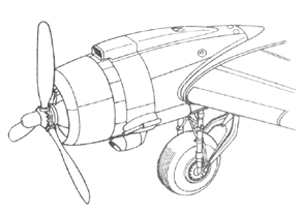 Adapted from
Aviakollectsia Adapted from
Aviakollectsia
|
The deliveries of C-47 for the lend-lease program started in October 1942 over
the ALSIB (Alaska- Siberia) route.
A total of 707 C-47 were delivered, partially replacing the similar Soviet-built
Li-2s, many of which were assigned to the night bomber role.
The Soviet pilots and ground crew were well impressioned by the quality and
reliability of the US-built planes, better made than the Soviet Li-2s. For example,
the medium time between faults was 2,5 times higher than that of the Li-2, and
replacing the engine required only 10 man-hours compared to 62 of a Li-2.
C-47s were preferred particularly for the VIP transport roles, and Stalin himself
travelled on a C-47 for his travel from Baku to Teheran to meet the U.S. President
Roosevelt and the British Prime Minister Winston Churchill in Teheran in December
1943.
The only point that was disliked was the lack of defensive armament, that was
present on Li-2s; few C-47s were modified and armed with a UTK-1 turret with
12,7 mm UBT machine gun, just as many Li-2s.
Starting from March 1943, some C-47 were assigned to civil operators, starting
with the registration X361; their number had increased to 79 in March 1944.
A total of 709 C-47s were delivered to the Soviet Union between 1943 and 1945;
345 of them were assigned to services other than the Air Force, including the
Navy and the Civil Aviation.
|
PAINTING OF U.S. C-47s
Before considering how the C-47s were painted in Soviet service, let's
see what was the U.S. livery. |
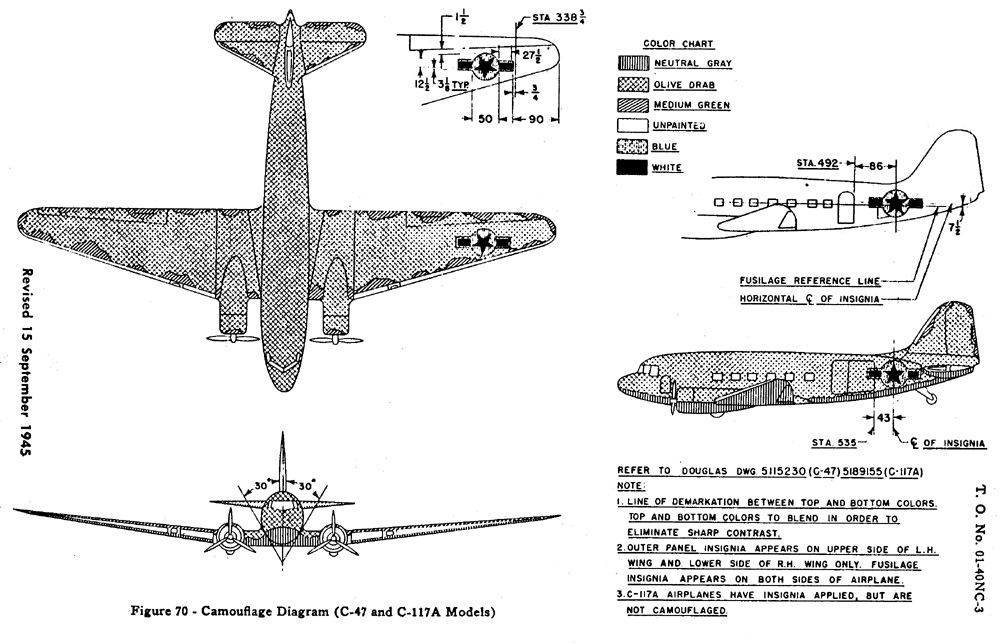
Image via Ilya Grinberg |
All the upper and side surfaces were painted in olive drab.
Olive drab41 (OD41) was introduced in 1941 as a standard paint for
US planes up to late 1943.
The color was similar to FS 33070 when new. This paint was not the
same of the Army ground forces.
In late 1943, the shades of OD of both Air Force and Ground Forces
were unified into the ANA 613 Olive Drab, that was a bit lighter and
more brownish than the shade of 1941, being similar to FS 34086, or
better to RAL 7013 braungrau.
ANA 613 was modified again in 1959, returning closer to FS 33070.
Although brand new Olive Drab paint changed only slightly between the
supplies of different producers, they were let free to use their own
combination of pigments. In consequence of their choices, the paint
changed in considerably different ways and amounts with the ageing;
usually it became more or less lighter and could turn to brownish, yellowish,
greenish or greyish shades in accordance to the most stable pigments
of the chosen combinations. It can be that different parts of the same
plane, painted with different stocks of OD paint before being assembled
together, changed their shade in markedly different way with ageing.
Many C-47s had the fuselage, the mid wing section and the engine cowlings
painted with an OD of more light and brownish shade than the outer wing
panels and tail. The fabric-skinned surfaces as rudder, ailerons and
elevators turned quickly to a lighter and more greyish shade of OD.
The contours of the wings and tail (horizontal and vertical)
were broken by blotches of Medium green, extending
inward from the edges up 20% of their chord.
Many C-47 had the central part of the fin, around the yellow number,
painted in medium green. Other ones had a blotch of medium green covering
the engine cowlings.
The use of medium green was previded in ambiguous terms in April 1941,
and was made more clear in the revision of June 1942. Medium green 42
was more or less similar to FS-34094; its successor ANA 612 (from September
1943) was similar but slightly lighter; on bw photos, they appear darker
than the OD. These colors fade to a lighter shade, mantaining a well
distinguishable green look. The medium green blotches were often discontinued
on planes produced in 1945.
All lower surfaces were painted with neutral gray.
Neutral grey 43 was introduced in 1941 and was similar to 36134. In
late 1943 it was replaced by the ANA 603 Sea grey, that was slightly
darker and more blue-purple, similar to FS 36132.
The leading edges of the wings, stabilizers and fin were covered
with a blackish de-icing defice, and were not painted with the livery
colors.
The drawing shows the standard position of the US nationality marks
un the sides of the fuselage, over the left wing and under the right
wing.
The internal surfaces were predominantly painted with yellow-green
zinc chromate paint; in late 1943, the slightly darker ANA
611 Interior green was introduced; it was similar to FS-34151.
|
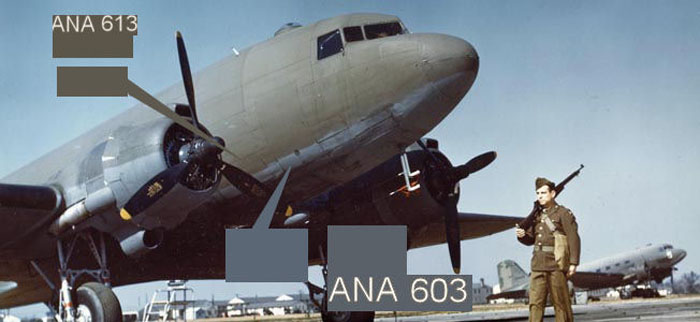 |
A color (or colorized) photo of some C-47A of U.S. Army Air Force.
It gives an excellent idea of the standard painting of U.S. C-47s.
The areas in olive drab and neutral grey are well indicated.
In addition, we can see areas of medium green 42/ANA 612 both on the
engine cowling of the closer plane and on the tail of the plane in the
background. This latter one shows also the lighter color of the olive
drab of the fabric-skinned rudder, common to the upper face of ailerons
and elevators.
Strangely, the serial numberon the fin of the far plane seems black
instead of the usual yellow.
Image from the web |

|
An excellent color photo shows the distribution of the medium green
42/ANA 612 on this US C-47B. The pattern change plane to plane.
Note that the fabric surfaces of the ailerons, elevators and rudder
appear of a khaki shade due to the ageing.
The red things on the tail are locks for elevators and ailerons, to
be removed before the takeoff.
Image from Real colors of WWII-Aircraft, ed. AK |
PAINTING OF SOVIET C-47
C-47s supplied to Soviet Union usually preserved the U.S. livery.
Red stars with white outline (unclear if with thin red outline too) were painted
on the fuselage, on the rudder (not always), under the wings.
The original U.S. markings were deleted before the delivery with the base paint,
and could be visible because of the scarce chromatic stability of the olive
drab paint. None available photo shows any Soviet C-47s with red star over the
wings; eventually one can see the trace of the deletion of the original US mark
over the left wing, made with olive drab paint in U.S.
The serial numbers, painted in yellow on the fin, were always preserved during
the war; eventually, they could have been deleted after the war's end.
The Soviet-made paintings were usually limited to some numbers on the fusolage
or rudder, and sometimes to a coloured cap atop the tail.
Limited retouches could have been made with Soviet paints; few planes show
a sort of camouflage made with Soviet colors over the OD base.
After the end of the wars, many C-47s were repainted with standard Soviet colors,
or with US-supplied olive drab or perhaps some Soviet imitation of it.
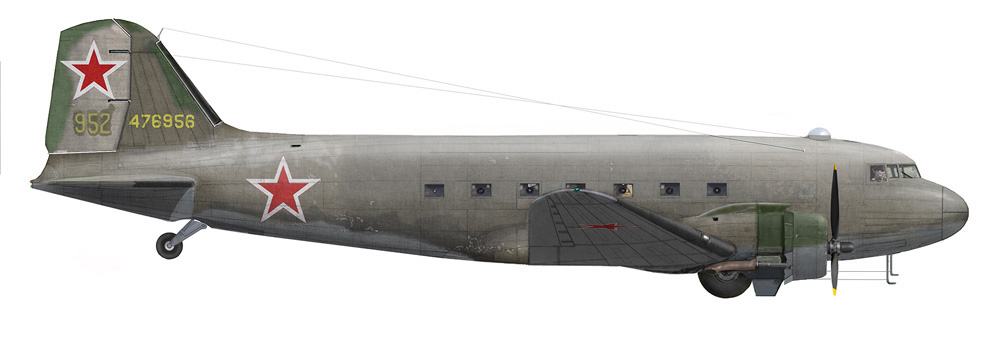 Drawing by Tapani
Tuomanen Drawing by Tapani
Tuomanen
|
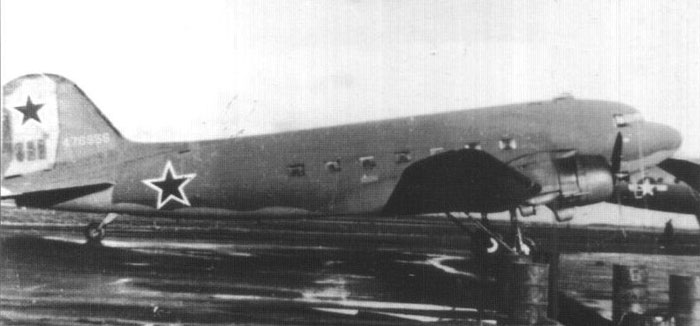
|
C-47B-35-DK (44-76956) still in U.S.A before being delivered to the
Soviet Union. The photo seems to show the numbers 952 on the rudder,
this suggests that it could have received the rudder of another plane.
The plane looks already used, worn and retouched at the time to send
it in Soviet Union.
It is interesting to note that the plane already had red stars before
its delivery to Soviet Union; so, eventual retouches around the red
stars have to be made with US paints.
Note that the blotches of medium green extend to the upper side of
the cowling.
Image from Red Stars 4 of Geust and Petrov. |
 Drawing by Tapani Tuomanen Drawing by Tapani Tuomanen
|
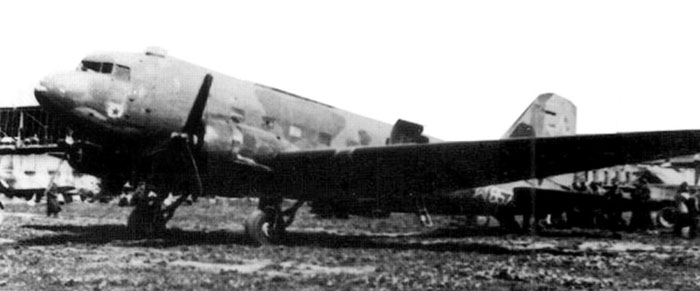
|
C47A-1-DK s/n 42-92330, 'white 857' on an unidentified
airport where the fighter unit Normandie Niemen was based in late 1944
or 1945.
The plane had a visible Guards emblem; it belonged to 10 GATD GVF (ex
1 ATD, Air Transport Division) that became Guards on 5 November 1944).
The plane looks to have camouflage dots on the olive base background;
probably they were made with A-24m dark green, A-21m light brown and
A-26m black, and perhaps with A-32m dark grey to roughly match Li-2s.
The photo seems to show black undersurfaces. The ribs on the back, similar
to those of turret-eqiopped Li-2s, suggest that this plane could have
been armed with a UTK-1 turret,removed at the time of the shot.
Another image shows this plane aside another C-47 with OD finish and
turret.
Images from Red Stars 4, of Geust and Petrov.
|
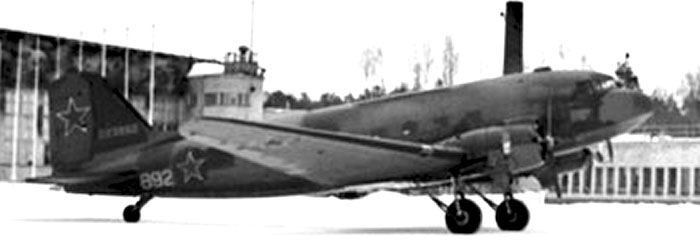
|
C-47A n.892. It looks to have been roughly camouflaged, probably
with light brown A-21m and perhaps dark grey to match the similar Soviet-built
Li-2s.
Unfortunately, the serial on the tail isn't clearly readable. |
 Drawing
by Tapani Tuomanen Drawing
by Tapani Tuomanen
|
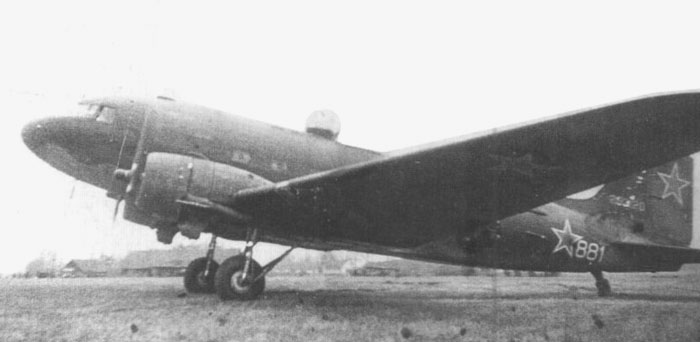
|
C-47A without air filter, probably s/n 42-93120, presumably
from the 101 Bomber Aviation Regiment of ADD, Svyatoshino airfield,
1944.
The supercharger intakes without the long filter over the cowling denote
an early production C-47A; the versionis recognizable because of the
small pipes for air heating aside the exhaust pipes.
The UTK-1 turret installed on the fuselage is relatively rare on C-47s,
but it was common on Soviet-built Li-2s.
The plane had blotches in medium green on the edges of the wings and
tail.
|
| |
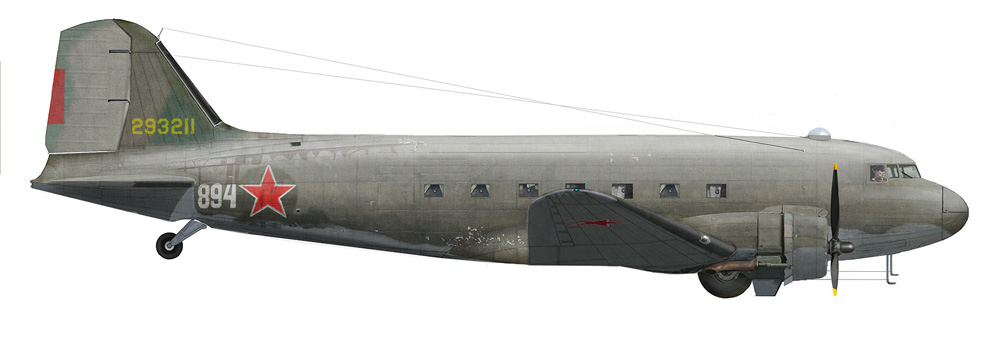 Drawing by Tapani Tuomanen Drawing by Tapani Tuomanen
|
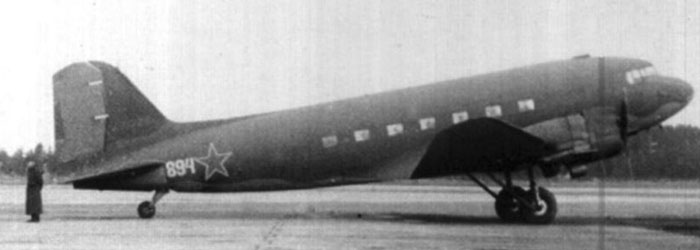
|
C-47A-20-DK (42-93211) 'white 94' in Utti, Finland, 20
September 1944. This plane had brought back to Finland the Finnish delegation
that went to Moscow, where the provisional peace agreement between the
Soviet Union and Finland was signed on 19 September 1944.
White 894 was in the Soviet civil register as L894 since 15 May 1944,
operated by the Detached Transport Escadrille (ote) of GVF. The duties
of this unit included the transport of high rank officers.
In November 1944, the unit was expanded and became 19 OTAP.
Image from Red Stars 4 of Geust and Petrov.
Left: the plane seen from both sides. One can see blotches, probably
of Medium green 42, both on the rudder and on the wing rear edge. The
bse color of the rudder was khaki, and the fin was repainted probably
in Soviet green to delete some previous marking. The serial numbers
are hardly readable, probably because of the green repainting.
Below: detail of the tail. Strangely, some digits seem black, this
could be due to the use of an ortochromatic film. The dark areas on
the fuselage are wet, probably.
|
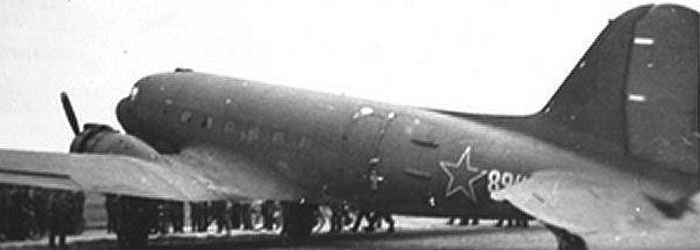
|
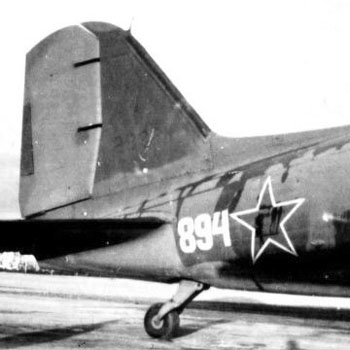
|
| |
 |
Plane White 44 with a reindeer emblem on its fin. The
serial is unreadable, unclear if this is due to the wartime censorship.
The engine cowling looks lighter than usual; it could have had some
distinctive color. |
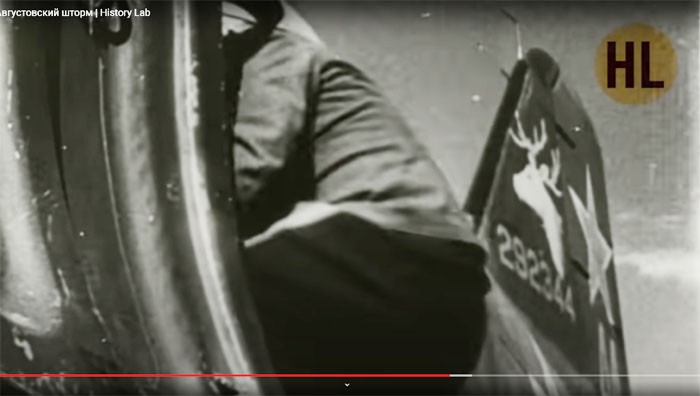 |
Screenshot with a detail showing the serial of the same plane, that
was 292344 (or better, 42-92344).
Being between 223300 to 348262, this identifies the plane as a C-47A.
Thanks to Alexey Matvienko. |
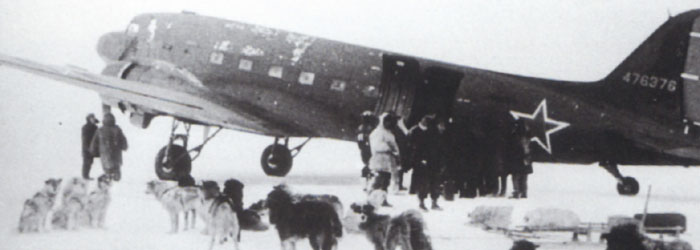
|
C-47B-25-DK (44-76376) in civil use.
The strange scratches atop the fuselage can give the idea to be related
to works for the remotion of a turret. |
 Drawing by Tapani Tuomanen Drawing by Tapani Tuomanen
|
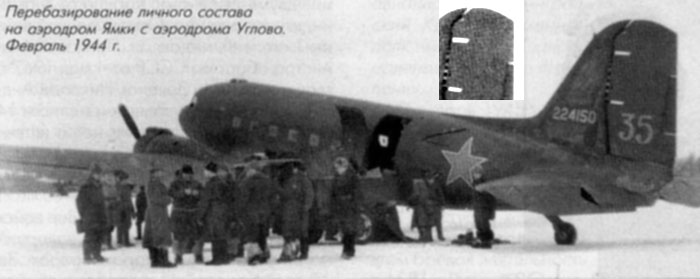
|
C-47A (s/n 42-24150) n.35 in February 1944.
A red star without white outline seems recognizable on the rudder.
Serial 42-24150 was sent to the USSR on August 5, 1943.
|
 Drawing
by Tapani Tuomanen Drawing
by Tapani Tuomanen |
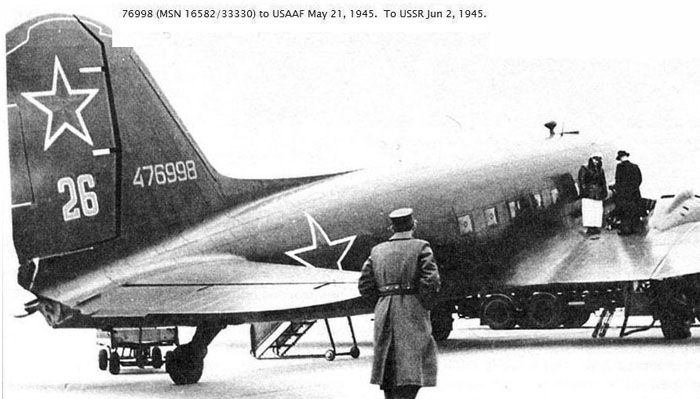
|
C-47B (s/n 44-76998) was delivered to USSR on 2 June 1945.
It belonged to 19 OTAO, an unit specialized in high rank officers transport.
, the red and white decoration on the tail was characteristic of this
unit.
It is unclear if the plane had still the original olive drab/neutral
grey US livery at the date of the photo, or it was repainted in Soviet
green AGT-4 and light blue AGT-7 as Soviet-built planes.
The side windows still have the central hatch for infantry weapons,
so it's likely that it still had its cargo door as standard.
The radiocompass drop fairing was mounted on the back as Li-2s; a smallmast
was installed on its right to connect one of the wires from the fin.
|
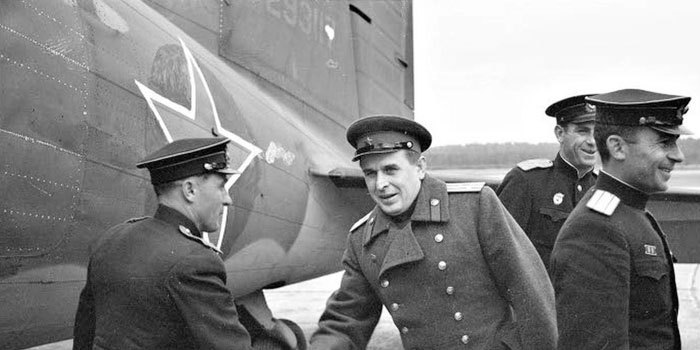
|
Interesting photo of plane s/n 293117 transporting Soviet high rank
officers.
A noticeable characteristic is that the long hinges of the cargo door
have been removed, so the door itself was fixed and only the passengers
door on it was still openable; this suggests that the inside layout
of the plane was changed into a VIP transport.
The outer finish is still the OD/NG standard. |
 Drawing by Tapani Tuomanen Drawing by Tapani Tuomanen
|
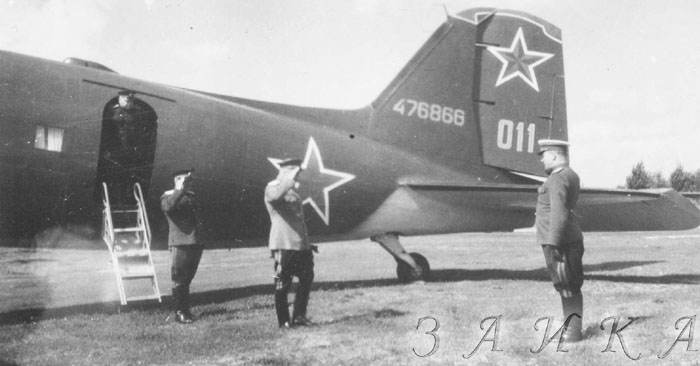
|
C-47B-35-DK s/n 476866 was received by the USSR in Spring
1945.
The photo depicts an arrival of Bulganin, who was Deputy People’s
Commissar of Defense.
The aircraft belongs to the 2nd ADON (Detached Division of Special
Purpose) – VIP transport unit.
The plane shows a passengers door instead of the usual cargo door and
an unknown device at the top of the fuselage; it is likely that the
plane was modified in Soviet Union after the delivery. The side windows
hadn't the central hatch for infantry weapons.
The colors don't seem olive drab and neutral grey, but Soviet green
A-24g and light blue A-28g with a glossy finish.
Image: archive Zaika
|
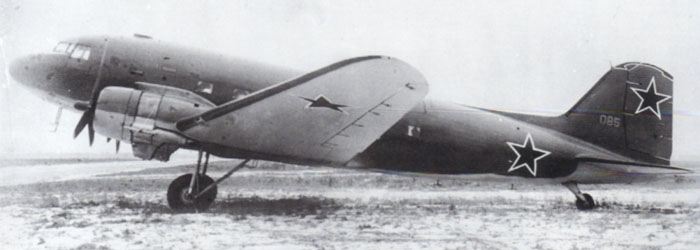
|
Plane '085' of 19 OTAO. The plane was repainted in Soviet green AGT-4
and light blue AGT-7, the red and white decoration on the tail was characteristic
of this unit.
The fully code is unreadable, so it isn't sure if this plane was a
C-47 A or B, but B is more likely.
The hinges of the cargo door aren't visible, so this plane had to be
transformed as the one seen above.
Image from Red Stars 4 of Geust and Petrov |
Postwar service with Aeroflot
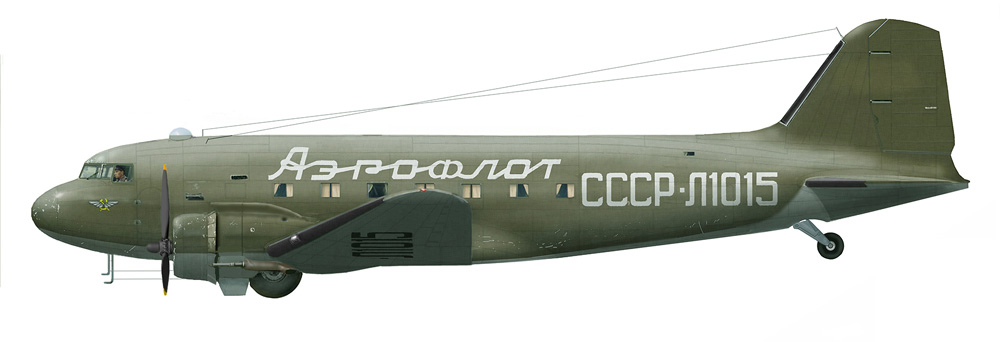 Drawing by Tapani
Tuomanen Drawing by Tapani
Tuomanen
|
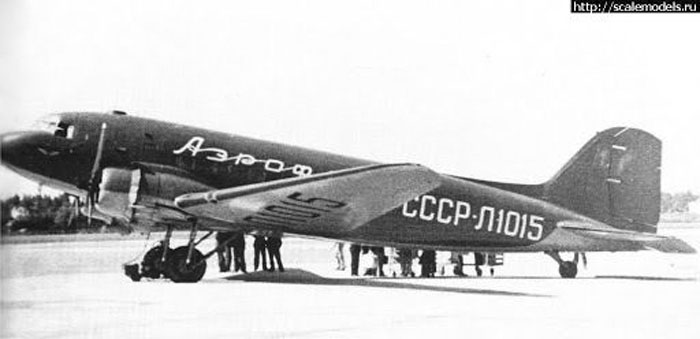
|
After the war's end, many C-47s remained in civil service
with the Aeroflot, with codes CCCP-L10xx.
These codes were reported in white on the fuselage sides and on the
wing uppersurfaces, and in black on the wing undersurfaces.
The emblem included a wide logo pf Aeroflot over the row of windows,
and a small emblem with white wings, and yellow hammer and sickle.
On the photo, the plane seems repainted with Soviet glossy colors,
unclear if standard AGT-4 and AGT-7 or a glossy imitation of U.S. olive
drab.
The U.S. serials, always preserved during the war, were now deleted.
The tail, excluded by the latest repainting, seems to bear some deleted
marking; it had no longer the original painting, but traces of some
intermediate one.
|
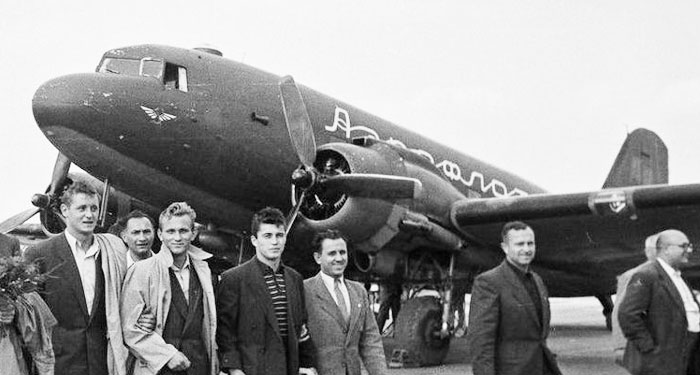
|
Left: another similar plane. The winged hammer and sickle is well
visible here. Again, we see the deletion of some previous marking on
the tail.
Below: another variation, probably earlier, was the logo 'Aeroflot'
painted on the nose sides.
The plane of the photo on the left is freshly repainted; the plane
below is worn and traces of the wartime marking can be seen on the fin.
Images from Red Stars 4 of Geust and Petrov |

|
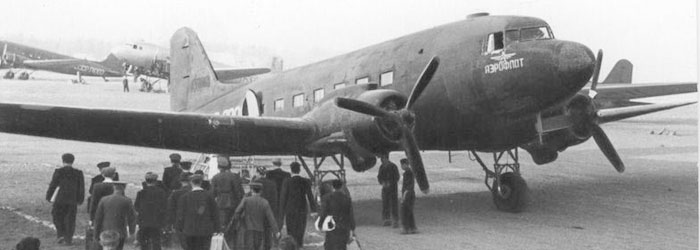
|
C-47s were still utilized in USSR up to the mid 50's, but the lack of spare
parts obstacled thei prolongation of their service.
Some C-47s received Soviet-built engines ASh-61IR or ASh82FN, being called
TS-62 and TS-82 respectively and used by Aeroflot up to 1957.
Bibliography:
Red stars 4, of Geust and Petrov, ed. Apali
C-47 Skytrain, Squadron Signal in Action n.149
Douglas C-47, Aviakollectsia 10/2008
Aerei Modelismo 3/1988
Links:
http://ewarbirds.org/08/c47040908/index.html
http://www.dc3history.org/home.html
https://www.britmodeller.com/forums/index.php?/topic/235090919-about-c-47-and-dc-3/
https://ww2incolour.blogspot.com/2012/07/russian-c-47-dakota-found-in-arctic.html
https://edition.cnn.com/travel/article/douglas-c47-salvage-mission-siberia-russia/index.html
http://legendsintheirowntime.com/LiTOT/C47/C47_index.html
Disclaimer: this work collects a lot of photos and drawings from many sources,
not always identified and mentioned.
If someone has rights on the images reproduced here, please don't feel hurted,
email to me and I shall provide to remove or to credit them.
 Adapted from
Aviakollectsia
Adapted from
Aviakollectsia 
 Adapted from
Aviakollectsia
Adapted from
Aviakollectsia 


 Drawing by Tapani
Tuomanen
Drawing by Tapani
Tuomanen 
 Drawing by Tapani Tuomanen
Drawing by Tapani Tuomanen


 Drawing
by Tapani Tuomanen
Drawing
by Tapani Tuomanen 
 Drawing by Tapani Tuomanen
Drawing by Tapani Tuomanen






 Drawing by Tapani Tuomanen
Drawing by Tapani Tuomanen

 Drawing
by Tapani Tuomanen
Drawing
by Tapani Tuomanen 

 Drawing by Tapani Tuomanen
Drawing by Tapani Tuomanen


 Drawing by Tapani
Tuomanen
Drawing by Tapani
Tuomanen 



